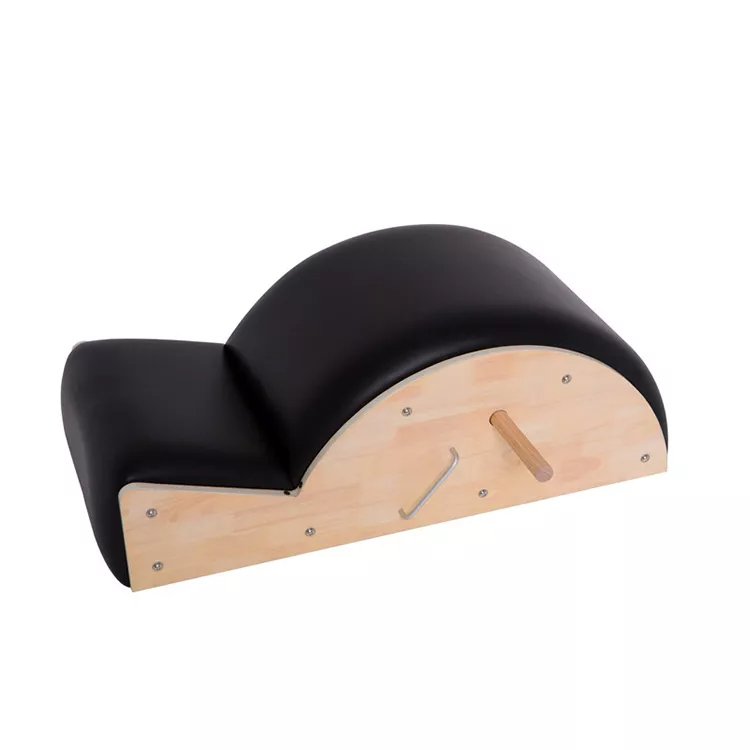
Introduce
In today’s fast-paced world, many people are looking for effective ways to improve their posture and alleviate back pain. One method that has gained significant popularity is Pilates. Known for its core-strengthening and flexibility-enhancing exercises, Pilates has become a go-to practice for individuals seeking better overall physical health. Among the various tools used in Pilates, the Pilates Spine Corrector stands out for its specific focus on spinal alignment and back health. This blog post will delve into the relationship between Pilates and spinal health, addressing whether it can help straighten the spine and improve posture. We will explore the effectiveness of the Spine Corrector, its proper usage, and its suitability for individuals with back issues.
Exploring the Pilates Spine Corrector
The Pilates Spine Corrector is a specialized piece of equipment designed to enhance the Pilates experience, particularly in relation to spinal alignment. Unlike other Pilates apparatus such as the Reformer or the Cadillac, the Spine Corrector is specifically engineered to target the curvature of the spine. It offers unique exercises that aim to stretch, strengthen, and balance the muscles around the spine, thereby promoting better posture and alleviating back pain.
One of the key attractions of the Spine Corrector is its ability to facilitate exercises that are challenging to perform on a mat. The curved surface of the Spine Corrector provides support and guidance, allowing for a greater range of motion and more precise targeting of spinal muscles. This can be particularly beneficial for individuals with tight or imbalanced muscles, as the Spine Corrector helps to lengthen and strengthen these areas more effectively.
As we delve deeper into the functionality and benefits of the Pilates Spine Corrector, several questions arise: Do spine correctors work? Does Pilates straighten the spine? What is the difference between flat back and neutral spine Pilates? How do you use the Pilates spine corrector? What exercises cannot be performed on the spine corrector? Is Pilates bad if you have a bad back? In the following sections, we will address these questions, providing comprehensive insights and practical advice.
Do Spine Correctors Work?
The effectiveness of spine correctors has been a topic of much discussion among fitness enthusiasts and health professionals. The fundamental principle behind the Pilates Spine Corrector is its ability to support and challenge the spine in a way that promotes optimal alignment. The curved surface is designed to mimic the natural curvature of the spine, encouraging proper posture and movement patterns.
Studies and anecdotal evidence suggest that spine correctors can indeed be effective. Users often report improvements in their posture, a reduction in back pain, and a greater sense of overall well-being. The key to their effectiveness lies in the way they facilitate spinal extension and flexion exercises, which are crucial for maintaining a healthy spine.
Moreover, the Pilates Spine Corrector helps to balance the muscles around the spine. By stretching tight muscles and strengthening weak ones, it can correct muscle imbalances that often lead to poor posture and back pain. Regular use of the spine corrector can lead to significant improvements in spinal health, making it a valuable tool for anyone looking to enhance their Pilates practice.
Does Pilates Straighten the Spine?
One of the most common questions about Pilates is whether it can actually straighten the spine. The answer is nuanced. Pilates itself is not designed to “straighten” the spine in the sense of correcting structural abnormalities such as scoliosis. However, Pilates can significantly improve spinal alignment by addressing muscle imbalances and promoting better posture.
The exercises performed in Pilates are designed to strengthen the core muscles, which include the muscles of the abdomen, back, and pelvis. A strong core provides a stable foundation for the spine, allowing for better posture and reduced strain on the back muscles. Over time, this can lead to an improvement in the alignment of the spine.
Furthermore, Pilates emphasizes controlled and precise movements, which can help to correct poor movement patterns that contribute to spinal misalignment. By practicing Pilates regularly, individuals can develop a greater awareness of their posture and movement, leading to long-term improvements in spinal health.
Flat Back vs. Neutral Spine in Pilates
In Pilates, understanding the difference between a flat back and a neutral spine is crucial for performing exercises correctly and safely. A flat back refers to a position where the lower back is pressed flat against the floor or a piece of equipment, eliminating the natural curve of the spine. This position is often used in specific exercises to target certain muscles more effectively.
On the other hand, a neutral spine refers to the natural alignment of the spine, where the curves of the cervical, thoracic, and lumbar regions are maintained. This position is considered the most stable and biomechanically efficient alignment for the spine. In Pilates, maintaining a neutral spine is often emphasized to promote optimal posture and reduce the risk of injury.
Both flat back and neutral spine positions have their place in Pilates. The key is to understand when and how to use each position. For example, a flat back may be beneficial in exercises that focus on core stabilization, while a neutral spine is ideal for movements that involve dynamic motion and balance.
How to Use the Pilates Spine Corrector?
Using the Pilates Spine Corrector effectively requires a good understanding of its purpose and proper technique. Here are some steps and tips for getting the most out of this versatile piece of equipment:
Familiarize Yourself with the Equipment
Before starting any exercises, take some time to understand the design and functionality of the Spine Corrector. Notice the curved surface and how it supports different parts of your spine.
Start with Basic Exercises
Begin with simple exercises to get comfortable with the Spine Corrector. Exercises like the Swan, Shoulder Bridge, and Mermaid are great for beginners. These exercises will help you get a feel for how the Spine Corrector supports your spine and aids in movement.
Focus on Alignment
Proper alignment is crucial when using the Spine Corrector. Ensure that your spine is correctly positioned on the equipment, maintaining either a flat back or a neutral spine as required by the exercise.
Engage Your Core
As with all Pilates exercises, engaging your core muscles is essential. This will help stabilize your spine and enhance the effectiveness of the exercises.
Progress Gradually
As you become more comfortable with the Spine Corrector, you can progress to more advanced exercises. These may include more dynamic movements and greater ranges of motion.
Listen to Your Body
Pay attention to how your body feels during and after exercises. If you experience any discomfort or pain, stop the exercise and consult with a Pilates instructor or healthcare professional.
Exercises Not Suitable for the Spine Corrector
While the Pilates Spine Corrector is a versatile piece of equipment, there are some exercises that may not be suitable for it. These include:
High Impact Exercises
The Spine Corrector is not designed for high impact or jumping exercises. These types of movements can compromise the stability of the equipment and increase the risk of injury.
Heavy Weight lifting
Exercises that involve lifting heavy weights are not appropriate for the Spine Corrector. The equipment is designed for bodyweight exercises and light resistance work.
Certain Flexibility Exercises
Some flexibility exercises that require extreme ranges of motion may not be suitable for the Spine Corrector. Always consult with a Pilates instructor to ensure that the exercises you are performing are safe and appropriate.
Is Pilates Bad if You Have a Bad Back?
Many people with back issues wonder whether Pilates is safe for them. The good news is that Pilates can be highly beneficial for individuals with back problems, provided it is done correctly and under the guidance of a qualified instructor. Pilates exercises are designed to strengthen the core muscles, improve flexibility, and promote better posture, all of which can help alleviate back pain and prevent future issues.
However, it is crucial to approach Pilates with caution if you have a bad back. Here are some tips to ensure that your practice is safe and effective:
Consult with a Healthcare Professional
Before starting Pilates, consult with a doctor or physical therapist to get a clear understanding of your condition and any limitations you may have.
Work with a Qualified Instructor
A certified Pilates instructor can provide personalized guidance and modifications to ensure that the exercises are safe and effective for your back.
Start Slowly
Begin with gentle exercises that focus on core stabilization and basic movements. Gradually progress to more challenging exercises as your strength and flexibility improve.
Avoid High-Risk Exercises
Certain Pilates exercises may be too intense or risky for individuals with back issues. Avoid exercises that involve deep spinal flexion or extension, as these can exacerbate back problems.
Listen to Your Body
Pay close attention to how your body responds to the exercises. If you experience any pain or discomfort, stop immediately and consult with your instructor or healthcare professional.
In Conclusion
Pilates offers a wealth of benefits for spinal health, from improving posture to alleviating back pain. The Pilates Spine Corrector is a valuable tool that can enhance these benefits by providing targeted support and challenge for the spine. While Pilates may not “straighten” the spine in the conventional sense, it can significantly improve spinal alignment and overall posture through its core-strengthening and flexibility-enhancing exercises.
By understanding the principles of flat back and neutral spine positions, and learning how to use the Spine Corrector effectively, practitioners can maximize the benefits of their Pilates practice. For those with back issues, Pilates can be a safe and effective way to manage pain and improve spinal health, provided it is approached with care and under professional guidance.
In conclusion, the relationship between Pilates and spinal health is a positive one, with the potential to bring about significant improvements in posture, flexibility, and overall well-being. Whether you are a seasoned practitioner or new to Pilates, incorporating the Pilates Spine Corrector into your routine can take your practice to the next level, helping you achieve a healthier, more aligned spine.






